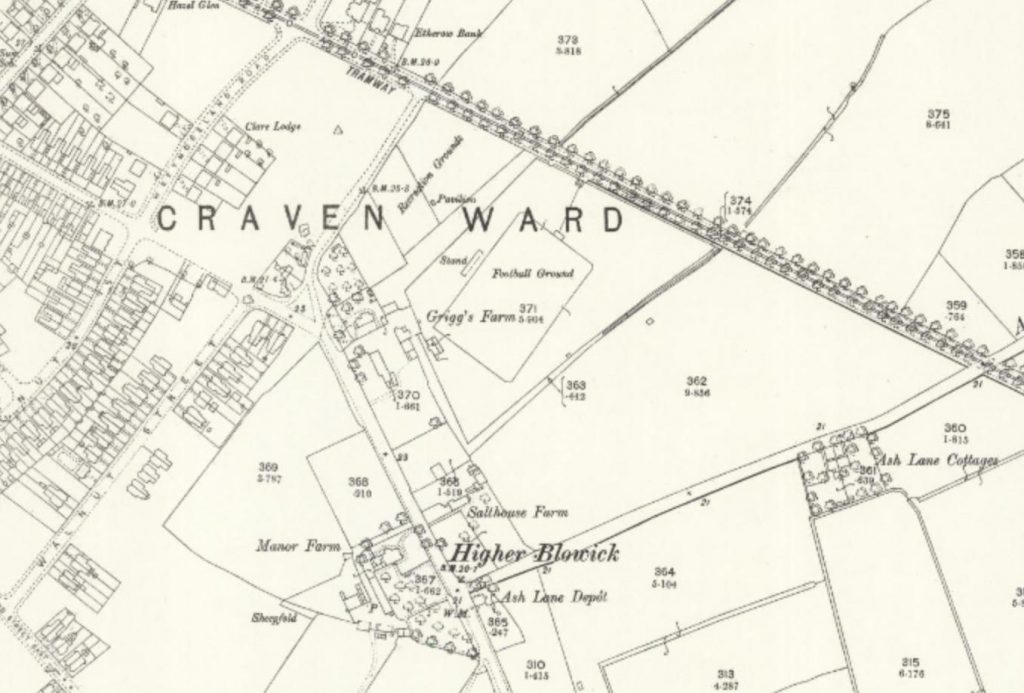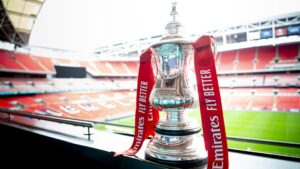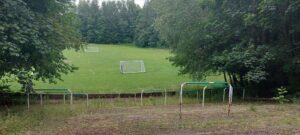29 April 1905 marked the end of a chapter in Southport’s footballing history as Southport Central played their final match at Scarisbrick New Road. The game itself, while unremarkable on paper, was historic in that it brought down the curtain on sixteen years at a ground that had witnessed the club’s transformation into a serious regional force. At the final whistle, players and supporters joined together as a band played Auld Lang Syne, bidding an emotional farewell to the place they had called home.
The Scarisbrick New Road ground in question was not the original field of that name but a second, distinct site. Its first known use was by the Southport Olympic Rugby Club in 1882, and they continued to play there until their disbanding in 1889. After a brief stint at Sussex Road upon their formation in 1888, Southport Central took over the ground and quickly established it as their permanent home.
An 1894 Ordnance Survey map clearly shows an enclosed field at the heart of what was then open land. Today, Falkland Road runs across the former pitch. A single surviving relic of the sporting area is Scarisbrick Bowling Club, accessed via a snicket off Falkland Road.
The Ordnance Survey map produced in 1894 indicates the location of an enclosure.

Reproduced with the permission of the National Library of Scotland.

Overlay created by David Walshe (Secret Sand Land @hiddensouthport), highlighting the location of the Scarisbrick New Road ground, the Scarisbrick Bowling Club and Ash Lane.

Image © THE BRITISH LIBRARY BOARD. ALL RIGHTS RESERVED.
Contemporary reports, most notably from the Southport Visiter, described the ground in glowing terms: “sufficiently extensive, thoroughly well laid out, capitally fenced and included two excellent pavilions and a covered grandstand.”
One of the most striking features was the construction of the grandstand and fencing. Much of it was made from pitch pine logs recovered from the dismantled S.S. Great Eastern, a colossal iron sailing steamship designed by Isambard Kingdom Brunel. The materials were bought by Isaac Smith, then Chairman of Southport Central, and repurposed for footballing use. These timbers would later be dismantled and re-erected at the club’s new ground on Ash Lane in 1905. It was, for its time, a highly respectable venue capable of supporting the club’s ambitions in regional football. The grandstand had seated accommodation for 2000 and about 20,000 more could view the game. No matter what the weather was like Scarisbrick New Road was always playable, and there was only one case on record when the match had to be postponed owing to inclemency.

Another iconic element of the matchday experience at Scarisbrick New Road came after 1895, when the new Southport Infirmary was constructed nearby. The hospital clock was visible from the ground and became an unofficial timekeeper for matches.
The 1904–05 campaign was the final one at Scarisbrick New Road, and perhaps the most memorable. Southport Central had just been promoted to the “A” Division of the Lancashire Combination and finished an impressive third, behind only Stockport County and Liverpool. But their greatest triumph came in the Lancashire Senior Cup, a competition they would win for the first and only time.
Their cup run included emphatic victories over Earlestown (6–1), Blackpool, and Liverpool’s full first team. The final took place at Scarisbrick New Road against Everton, who fielded their reserve side with their first team engaged in a clash with Aston Villa the following day. A crowd of 5,000 witnessed Lawson and Smith give Central a 2–0 lead at half-time. Despite a strong Everton comeback attempt – Caldwell hit the post and Dilly pulled one back – Central held on for a famous win. The trophy was displayed in Fred Dunkerley’s sports shop by day, and secured at the local police station overnight.

Off the pitch, the storm clouds had been gathering since July 1903 when the club’s committee had been formally notified that their ground was wanted for building. Their efforts to secure the site permanently were rebuffed and an alternative proposal at Kew Gardens fell through due to complications with property trustees.
With pressure mounting and no home secured, a meeting with Sir Charles Scarisbrick and Captain Cross resulted in negotiations for a new field. A site on Ash Lane, owned by Mr. Rimmer, a local farmer, was identified and surveyed. Terms were agreed for a five-year tenancy at £30 per annum, allowing Southport Central to move forward. Materials from the Scarisbrick New Road ground, including the old grandstand, were salvaged and transported across town for the development of what would later become Haig Avenue. The old wooden stand would remain at Haig Avenue until it was destroyed by fire on the evening following Southport’s game against Wrexham on Boxing Day 1966.
The last match at Scarisbrick New Road was modest on the scoreboard, a 1–1 draw with Darwen, but monumental in its meaning. The shared goals were almost incidental to the occasion. As the game ended, the crowd linked arms and sang “Auld Lang Syne”, knowing they were witnessing the close of a treasured chapter in Southport’s sporting history.
Today, there are no visible remnants of the ground. The area has long been absorbed into Southport’s residential fabric. Yet, for those who know where to look, and who study the maps and memories of the time, the legacy of Scarisbrick New Road lives on.
It was here that Southport Central really laid the foundations for a professional future, developed its identity, and built a fanbase. The move to Ash Lane may have signalled a new beginning, but it was at Scarisbrick New Road where the club’s story truly began to grow.
More Info:
Matches Played at Scarisbrick New Road 2
Read an excellent account of the transition from Scarisbrick New Road to Ash Lane
Discover more from Southport Central
Subscribe to get the latest posts sent to your email.

 1 - 3 v FC Halifax Town (H) 11/10/2025
1 - 3 v FC Halifax Town (H) 11/10/2025 




More Stories
The Price Of Saying No
Friday Night Football
Fifty Years On: Counting the Cash, Missing the Moment